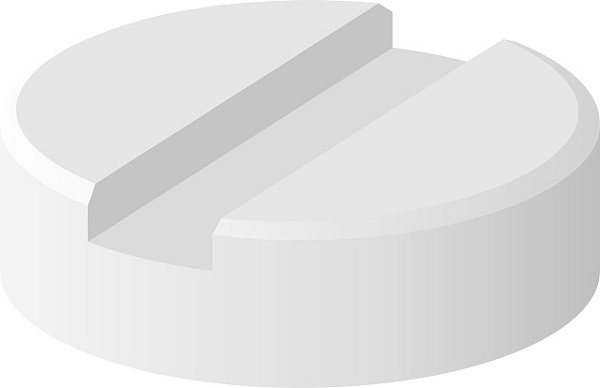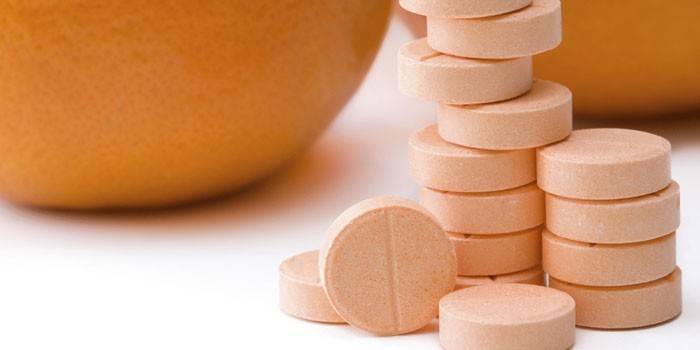pharmachologic effect
Vitamin C. Ascorbic acid is necessary for the formation of intracellular collagen and is required to strengthen the structure of teeth, bones and capillary walls. Participates in redox reactions, tyrosine metabolism, conversion of folic acid into folinic acid, carbohydrate metabolism, lipid and protein synthesis, iron metabolism, cellular respiration processes, activates the synthesis of steroid hormones. Reduces the need for vitamins B1, B2, A, E, folic acid, pantothenic acid, helps increase the body's resistance to infections; improves iron absorption, promoting its deposition in a reduced form. Has antioxidant properties. When used intravaginally, ascorbic acid reduces the pH of the vagina, inhibiting the growth of bacteria and helps restore and maintain normal pH and vaginal flora (Lactobacillus acidophilus, Lactobacillus gasseri).
Overdose and side effects
If you significantly exceed the dosage of ascorbic acid, its effectiveness will not increase.
On the contrary, it can aggravate some problems of the body, or create new ones.
In addition, excessive consumption of vitamin C increases the feeling of hunger and appetite, and accordingly increases cravings for unhealthy and high-calorie foods.
Indications for use
For systemic use: prevention and treatment of hypo- and vitamin C deficiency; ensuring the body's increased need for vitamin C during growth, pregnancy, lactation, heavy loads, overwork, and during convalescence after long-term serious illnesses; in winter, with an increased risk of developing infectious diseases. For intravaginal use: chronic or recurrent vaginitis (bacterial vaginosis, nonspecific vaginitis) caused by anaerobic flora (due to altered vaginal pH); in order to normalize the disturbed vaginal microflora.
Recommended daily dose
The daily dose of ascorbic acid varies from 0.05 mg to 100 mg , depending on age, physical and mental stress, etc.

increases significantly if a person:
- experiences increased stress on the body,
- engages in heavy physical labor,
- is under prolonged mental stress,
- experiencing emotional disturbances
- susceptible to infection or pain.
Daily dosage of vitamin C for preventive purposes :
- For adults - 50-100 mg (1-2 tablets of 50 mg), 3-5 times a day, after meals;
- For children (from 5 years old) - 50 mg (1 tablet), 2-3 times a day, after meals.

Maximum doses
The maximum single dose for adults is no more than 200 mg, the daily dose is no more than 500 mg .
For children, the daily dosage is significantly less:
- 0-6 months - 30 mg;
- 6-12 months - mg;
- 1-3 years - 40 mg;
- 4-10 years - 45 mg;
- 11-14 years - 50 mg.
Mode of application
Ascorbic acid with glucose is prescribed for the prevention and treatment of infectious diseases in weakened patients. The prophylactic dose for an adult is 0.5-1 tablets/day, the therapeutic dose is from 1.5 to 5 tablets/day. For children over 5-6 years old, the prophylactic dose is 0.5 tablets/day. therapeutic - 1-3 tablets/day. Glucose with ascorbic acid is prescribed intravenously to prevent secondary infection, pulmonary edema, renal hepatic failure and a number of other pathologies. The benefits of this remedy are also enormous for pregnant women who suffer from severe toxicosis and need additional support for the body. In each specific case, the dose is selected individually. Reviews indicate that many people (especially people on a diet) use ascorbic acid tablets with glucose instead of prohibited sweets, believing that they are less harmful. The calorie content of glucose is 340 kcal, and one tablet contains 877 mg. That is, 1 tablet is approximately 30 kcal. However, using the drug instead of sweets and regularly exceeding the daily requirement of vitamin C is fraught with serious stomach problems.
What is ascorbic acid used for?
Stimulating the synthesis of corticosteroid hormones, improving the absorption of iron (which helps get rid of anemia), and generally strengthening the immune system - this is why ascorbic acid is mainly taken, which few people perceive as a full-fledged medicine. However, vitamin C, especially when combined with glucose, can have a serious effect on the body due to its rapid penetration into blood cells and tissues in the form of dehydroascorbic acid. The benefits of this drug can be appreciated even with frequent headaches caused by blood thickening.
Regarding the pharmacodynamics of ascorbic acid:
- Metabolism occurs in the kidneys, most of which is excreted as oxalate.
- The rate of excretion by the kidneys depends on the dose - high doses come out faster.
Composition and release form
The main components of the drug are already indicated in the name - these are vitamin C and glucose, their concentration is the same, if we consider the most common form of release: hard tablets (chewable tablets are less common, the dose of active components is doubled). They are white, flat, with a central notch and without a shell - from the photo you can see that they are no different from classic ascorbic acid. The taste is sour. Additionally, the composition includes substances that give the tablets a dense shape, so it looks like this:
| Main components (dosage per 1 tablet) | Auxiliary components |
| Ascorbic acid (100 mg) | Potato starch |
| Glucose (877 mg) | Talc |
| Stearic acid |
What are the benefits of ascorbic acid with glucose?
In addition to eliminating the deficiency of specific substances, vitamin C is a participant in carbohydrate metabolism, is necessary for normal blood clotting, and plays an important role in the synthesis of hormones (mainly steroids) and collagen. With long-term use of ascorbic acid, a person does not need to take additional folic acid; the need for pantothenic acid and retinol disappears. Additionally she:
- Has an antiplatelet effect.
- Stimulates the synthesis of prothrombin.
- Blocks the release of histamine.

- Fat burners for girls: sports nutrition and reviews
- How to iron trousers with creases
- Fractional meals
Indications for use
Ascorbic acid with glucose is prescribed to children primarily for general strengthening of the body. In adults, there are more reasons to take it: firstly, ethanol and nicotine deplete ascorbic acid reserves (ethanol clearance increases), so if they are abused, periodic use of this drug is mandatory. Secondly, ascorbic acid with glucose is prescribed to adults as a reducing agent in the following cases:
- fractures;
- bleeding;
- intoxications;
- poor absorption of iron;
- infectious diseases;
- poor skin regeneration;
- overdose of anticoagulants.
Interaction
When used simultaneously with barbiturates and primidone, the excretion of ascorbic acid in the urine increases. With simultaneous use of oral contraceptives, the concentration of ascorbic acid in the blood plasma decreases. When used simultaneously with iron supplements, ascorbic acid, due to its restorative properties, converts ferric iron into divalent iron, which helps improve its absorption. Ascorbic acid in high doses can reduce urine pH, which, when used simultaneously, reduces the tubular reabsorption of amphetamine and tricyclic antidepressants. When used simultaneously, acetylsalicylic acid reduces the absorption of ascorbic acid by about a third. When used simultaneously with warfarin, the effects of warfarin may be reduced. When used concomitantly, ascorbic acid increases iron excretion in patients receiving deferoxamine. When using ascorbic acid at a dose of 500 mg/day, left ventricular dysfunction may occur. When used simultaneously with tetracycline, the excretion of ascorbic acid in the urine increases. A case of a decrease in the concentration of fluphenazine in the blood plasma in a patient receiving ascorbic acid 500 mg 2 times a day is described. It is possible to increase the concentration of ethinyl estradiol in the blood plasma when used simultaneously as part of oral contraceptives.
Calorie content Ascorbic acid. Chemical composition and nutritional value.
Nutritional value and chemical composition of “Ascorbic acid”.
The table shows the nutritional content (calories, proteins, fats, carbohydrates, vitamins and minerals) per 100 grams of edible portion.
| Nutrient | Quantity | Norm** | % of the norm in 100 g | % of the norm in 100 kcal | 100% normal |
| Calorie content | 382 kcal | 1684 kcal | 22.7% | 5.9% | 441 g |
| Squirrels | 0.1 g | 76 g | 0.1% | 76000 g | |
| Fats | 0.1 g | 56 g | 0.2% | 0.1% | 56000 g |
| Carbohydrates | 95.5 g | 219 g | 43.6% | 11.4% | 229 g |
| Alimentary fiber | 0.5 g | 20 g | 2.5% | 0.7% | 4000 g |
| Vitamins | |||||
| Vitamin C, ascorbic acid | 833 mg | 90 mg | 925.6% | 242.3% | 11 g |
The energy value of Ascorbic acid is 382 kcal.
Primary Source: Created in the application by the user. Read more.
** This table shows the average levels of vitamins and minerals for an adult. If you want to know the norms taking into account your gender, age and other factors, then use the “My Healthy Diet” application.
Side effect
From the side of the central nervous system: headache, feeling of fatigue, insomnia. From the digestive system: stomach cramps, nausea and vomiting. Allergic reactions: isolated cases of skin reactions and manifestations from the respiratory system have been described. From the urinary system: when used in high doses - hyperoxaluria and the formation of kidney stones from calcium oxalate. Local reactions: with intravaginal use - burning or itching in the vagina, increased mucous discharge, hyperemia, swelling of the vulva. Other: feeling of heat.
Contraindications
Hypersensitivity to ascorbic acid.
Use during pregnancy and lactation The minimum daily requirement for ascorbic acid in the second and third trimesters of pregnancy is about 60 mg. Ascorbic acid penetrates the placental barrier. It should be borne in mind that the fetus can adapt to high doses of ascorbic acid taken by a pregnant woman, and then the newborn may develop ascorbic acid syndrome as a withdrawal reaction. Therefore, during pregnancy you should not take ascorbic acid in high doses, unless the expected benefit outweighs the potential risk. The minimum daily requirement during lactation (breastfeeding) is 80 mg. Ascorbic acid is excreted in breast milk. A maternal diet containing adequate amounts of ascorbic acid is sufficient to prevent deficiency in the infant. It is not known whether maternal use of ascorbic acid in high doses is dangerous for the child. Theoretically this is possible. Therefore, it is recommended that a nursing mother not exceed the maximum daily requirement for ascorbic acid, unless the expected benefit outweighs the potential risk.
Calorie content Ascorbic acid. Chemical composition and nutritional value.
Nutritional value and chemical composition of “Ascorbic acid”.
The table shows the nutritional content (calories, proteins, fats, carbohydrates, vitamins and minerals) per tablet of the edible portion.
| Nutrient | Quantity | Norm** | % of the norm in 100 g | % of the norm in 100 kcal | 100% normal |
| Calorie content | 10 kcal | 1684 kcal | 0.6% | 6% | 16840 g |
| Carbohydrates | 2.5 g | 219 g | 1.1% | 11% | 8760 g |
| Vitamins | |||||
| Vitamin C, ascorbic acid | 25 mg | 90 mg | 27.8% | 278% | 360 g |
The energy value of Ascorbic acid is 10 kcal.
Primary Source: Created in the application by the user. Read more.
** This table shows the average levels of vitamins and minerals for an adult. If you want to know the norms taking into account your gender, age and other factors, then use the “My Healthy Diet” application.
Overdose
An overdose of Ascorbic acid develops with prolonged use of doses exceeding 1 gram per day. Its signs are: - headache; - nausea; - insomnia; - increased excitability of the central nervous system; - ulceration of the mucous membrane of the digestive canal; - vomit; - diarrhea; — inhibition of the functional activity of the pancreas insular apparatus; - nephrolithiasis; - oxalosis; - hyperacid gastritis; - moderate pollakiuria; - damage to the glomerular (glomerular) apparatus of the kidneys; - decreased permeability of capillary walls. In some cases, blood pressure and blood clotting increase, tissue trophism worsens, and microangiopathies develop. Intravenous administration of high doses of vitamin C can provoke erythrocytolysis and abortion. The lethal dose of vitamin C is 20-30 grams.
Ascorbic acid - side effects
According to doctors, even vitamins can be harmful, and an overdose of ascorbic acid with glucose is not necessary for this: even if you follow the instructions, a person may experience nausea, skin rashes and itching (allergies). Additionally, doctors note:
- The occurrence of diarrhea, intestinal spasms.
- Hypokalemia and thrombocytosis in test results.
- Distortion of indicators for the activity of transaminases and bilirubin.
- In the presence of tumors that form metastases, taking ascorbic acid with glucose is undesirable, since acceleration of this process is possible.
special instructions
Use with caution in patients with hyperoxaluria, impaired renal function, or a history of urolithiasis. Because ascorbic acid increases iron absorption, its use in high doses may be dangerous in patients with hemochromatosis, thalassemia, polycythemia, leukemia and sideroblastic anemia. In patients with high iron levels in the body, ascorbic acid should be used in minimal doses. Use with caution in patients with glucose-6-phosphate dehydrogenase deficiency. The use of ascorbic acid in high doses can cause an exacerbation of sickle cell anemia. Data on the diabetogenic effect of ascorbic acid are contradictory. However, with long-term use of ascorbic acid, blood glucose levels should be periodically monitored. It is believed that the use of ascorbic acid in patients with rapidly proliferating and widely disseminated tumors may aggravate the process. Therefore, ascorbic acid should be used with caution in patients with advanced cancer. The absorption of ascorbic acid decreases with the simultaneous consumption of fresh fruit or vegetable juices and alkaline drinks.
Special instructions for the use of Ascorbic acid with glucose
Due to the stimulating effect of the drug on hormonal synthesis, it is necessary to monitor kidney function and blood pressure, and with a prolonged course or use of an increased dosage, the level of insulin production by the pancreas.
With rapid oncogenesis, ascorbate can aggravate the patient's condition. If the iron content in the body is increased, the dose is reduced to a minimum.
Absorption of the drug is impaired in the presence of Aspirin, oral contraceptives, juices and alkaline drinks. Ethanol intake, long-term use of salicylates, fluoroquinolones, and steroid hormones lead to depletion of vitamin reserves, and sleeping pills and antiepileptic medications increase its excretion by the kidneys.
The possibility of distortion of some laboratory parameters should be taken into account: the concentration of bilirubin and glucose, the activity of lactate dehydrogenase and liver enzymes.

Vitamin C is also sold in the form of effervescent tablets.
The vitamin enhances the effect of penicillin and tetracycline antibiotics, reduces the effectiveness of oral contraceptives, neuroleptics and anticoagulants. When used simultaneously with sulfonamides and salicylic acid derivatives, the risk of developing crystalluria increases.
Vitamin C in the form of effervescent tablets of 0.25 and 1 g has a similar effect.
For diabetics
Diabetes mellitus is a contraindication for the use of this drug. If absolutely necessary, after comparing the possible benefits and harms, it can be taken for a short time in minimal quantities. This is done under the supervision of a doctor and subject to correction of the amount of carbohydrates consumed.
For children
The drug is not recommended for children under 6 years of age, but if necessary, it can be prescribed from 3 years of age. Optimal single dosages:
- 3-7 years - 50 mg;
- 7-10 years - 50-100 mg;
- 10-14 years - 100-150 mg.
Children over 14 years of age can be prescribed the same doses as adults. Frequency of administration: 1-3 times a day.
Can pregnant women drink?
The need to administer ascorbate during pregnancy is determined by the doctor. The drug penetrates the placental barrier, so you must strictly adhere to the prescribed dosages. The baby may become accustomed to large amounts of the vitamin, resulting in withdrawal symptoms after birth.

The intake of ascorbic acid during pregnancy must be determined by the attending physician.
Where to buy Ascorbic acid tablets No. 10 with glucose
The drug is delivered throughout Russia and the CIS. The goods are paid for only upon receipt. As a rule, the price of Ascorbic acid tablets No. 10 with glucose in pharmacies is much higher than on the Internet. You can consult and get more detailed information about the product by entering contacts on the official website, the operator will call you back within a few minutes.
The discounted price on the official website is 5 rubles.
Go to the official website Ascorbic acid tablets No. 10 with glucose
Calorie content Ascorbic acid. Chemical composition and nutritional value.
Nutritional value and chemical composition of “Ascorbic acid”.
The table shows the nutritional content (calories, proteins, fats, carbohydrates, vitamins and minerals) per piece of edible part.
| Nutrient | Quantity | Norm** | % of the norm in 100 g | % of the norm in 100 kcal | 100% normal |
| Calorie content | 19.6 kcal | 1684 kcal | 1.2% | 6.1% | 8592 g |
| Carbohydrates | 14 g | 219 g | 6.4% | 32.7% | 1564 g |
| Vitamins | |||||
| Vitamin C, ascorbic acid | 25 mg | 90 mg | 27.8% | 141.8% | 360 g |
The energy value of Ascorbic acid is 19.6 kcal.
Primary Source: Created in the application by the user. Read more.
** This table shows the average levels of vitamins and minerals for an adult. If you want to know the norms taking into account your gender, age and other factors, then use the “My Healthy Diet” application.











